| Author |
Message |
|
Roman Bachnak
Location: Surbiton Joined: 04 Jan 2010
Posts: 9
|
 Posted: Mon 04 Jan, 2010 4:35 pm Post subject: Unetice culture (1800 - 1600 BC) dagger Posted: Mon 04 Jan, 2010 4:35 pm Post subject: Unetice culture (1800 - 1600 BC) dagger |
 |
|
I am looking for information on the bronze age dagger illustrated on the images below. From preliminary reseach - which may or may not be accurate - it is possibly a dagger belonging to the Unetice culture (1800 - 1600 BC).
I am looking for info on dating / cultural and geographical placement / variants withing the culture etc.
Many thanks.
Roman





|
|
  |
 |
|
Vaclav Homan
Location: Hradec, Czech Joined: 22 Jan 2008
Posts: 90
|
 Posted: Mon 04 Jan, 2010 11:52 pm Post subject: Posted: Mon 04 Jan, 2010 11:52 pm Post subject: |
 |
|
Origin Unetice culture is in Czech Republik. Name Unetice is form village near Prag Únětice there was durind seventies yearst 19 century first archaeological excavation and determination attribute this culture.
Unetice culture exist during longer time 2200-1700(1600). Origin is in eneolit effects from Balkan and eneolithic culture in central europa. Extension of this important culture was in central europa (Czech, German, Austria, Poland, Slovakia).
This culture was first bronze age culture but bronze was not common as in late bronze time. End of thi culture was in Veterovicer culture with pre-urbal cultural atmosphere under interaction with Greece. And this development ended natural calamity.
This dagger is tipical for this culture in later time.
Prehistoric localities are in this time under pressure tumb robbers wiht metal detectors. This damnable and illegal activity make irrecoverable worse (damage) for higher research history. This problem i the greatest danger for archaeology and buy this artefact help to damage more localities.
There is only one art of fence yet many ways to reach it
|
|
  |
 |
|
Roman Bachnak
Location: Surbiton Joined: 04 Jan 2010
Posts: 9
|
 Posted: Tue 05 Jan, 2010 2:08 am Post subject: Unetice culture (1800 - 1600 BC) dagger Posted: Tue 05 Jan, 2010 2:08 am Post subject: Unetice culture (1800 - 1600 BC) dagger |
 |
|
Thank you for the informatiopn. The dagger has been acquired from a reputable auction house in Switzerland and originates from an ancient arms collection from early 1900s. Items from the same collection were also sold recently by Christies London. There is a legal to way to aquire items such as the dagger but, of course, that involves buying only from reputable sources.
Regarding the research about this dagger, would you be able to point me to any literature about Unetice culture and its arms? Does any museum in the Czech Republic (or elsewhere) have informative collection on the Unetice culture? Some specific question I have is whether this dagger had a practical application (as a weapon) or was it a status symbol?
Roman
|
|
  |
 |
Stephane Rabier

|
 Posted: Tue 05 Jan, 2010 2:29 am Post subject: Posted: Tue 05 Jan, 2010 2:29 am Post subject: |
 |
|
Hi,
very interesting.
Are the rivets and the tang end real or do they simulate a two part weapon: blade + hilt and everything is actually one piece?
|
|
  |
 |
|
Jeroen Zuiderwijk
Industry Professional
|
 Posted: Tue 05 Jan, 2010 3:34 am Post subject: Re: Unetice culture (1800 - 1600 BC) dagger Posted: Tue 05 Jan, 2010 3:34 am Post subject: Re: Unetice culture (1800 - 1600 BC) dagger |
 |
|
| Roman Bachnak wrote: | | Some specific question I have is whether this dagger had a practical application (as a weapon) or was it a status symbol? |
This was a true weapon, and the direct forerunner of swords in Europe. They evolved out of the copper daggers that were part of the standard weapon package in the Beaker cultures through most of Europe. The beaker culture male graves typically contained copper/flint daggers, archery equipement and/or stone/copper battle axes and flint or possibly copper axes. The archery equipment and battle axes mostly disappeared in the bronze age, and the halberd and bronze axe formed the standard weapons package next to these bronze daggers. As the bronze age progressed, the daggers grew into the early swords like the Sogel and Wohlde swords, and the halberds were replaced with spearheads. It's probable that the daggers still functioned as tools as well. By the time they had evolved into true swords, the urnfield culture introduced the single edged knife to fill in the gap in function as tool.
Of course the dagger would have functioned as status symbol as well, as in showing the status as warrior. In old archeology status was mistakingly seen as opposite of functional, while in general function and status are the same. The status as warrior is shown by his weapons. The richness of the equipment can also show wealth where it adds f.e. esthetic value rather then function, but it doesn't take away the function of the weapons.
Jeroen Zuiderwijk
- Bronze age living history in the Netherlands
- Barbarian metalworking
- Museum photos
- Zip-file with information about saxes
|
|
   |
 |
|
Vaclav Homan
Location: Hradec, Czech Joined: 22 Jan 2008
Posts: 90
|
 Posted: Tue 05 Jan, 2010 7:24 am Post subject: Posted: Tue 05 Jan, 2010 7:24 am Post subject: |
 |
|
Jeron have true this dagger was attribute of power, for battle they using mor flint arows stones axes.
Literature obout Unetice culture that I known is in Czech and German. On-line museas we have not.
[/img]
 Attachment: 34.75 KB Attachment: 34.75 KB
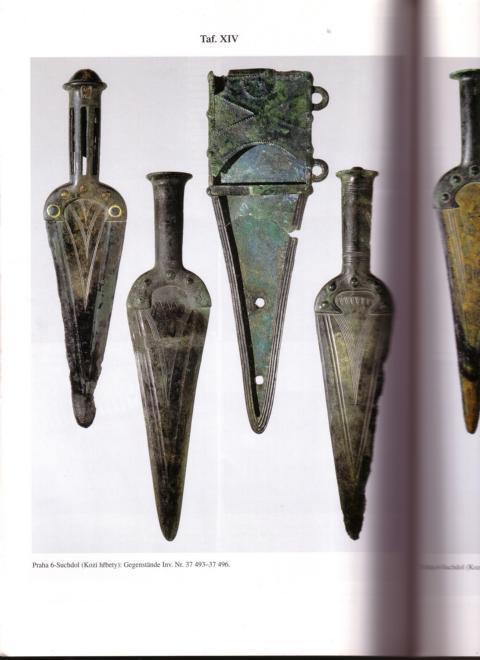
There is only one art of fence yet many ways to reach it
|
|
  |
 |
|
Roman Bachnak
Location: Surbiton Joined: 04 Jan 2010
Posts: 9
|
 Posted: Tue 05 Jan, 2010 8:16 am Post subject: Unetice culture (1800 - 1600 BC) dagger Posted: Tue 05 Jan, 2010 8:16 am Post subject: Unetice culture (1800 - 1600 BC) dagger |
 |
|
Stephane - The rivets seem to be real.
Jeroen - Thank you for your very informative post. I begin to see that "a status symbol" in these early cultures must in effect be equivalent to "a symbol of power" which if applied to weapons must mean that they were fully functional and used as such. On the issue of dating, perhaps I am reading too much into your post, but is it fair to say that this dagger is one of the earliest bronze weapons (in Europe)?
Vaclav - Thank you for posting the photos; what publication are those from? I would be grateful if you can post / email more about Unetice culture (Czech or German OK).
Roman
|
|
  |
 |
|
Vaclav Homan
Location: Hradec, Czech Joined: 22 Jan 2008
Posts: 90
|
|
  |
 |
|
Jeroen Zuiderwijk
Industry Professional
|
 Posted: Tue 05 Jan, 2010 1:26 pm Post subject: Re: Unetice culture (1800 - 1600 BC) dagger Posted: Tue 05 Jan, 2010 1:26 pm Post subject: Re: Unetice culture (1800 - 1600 BC) dagger |
 |
|
| Roman Bachnak wrote: | Stephane - The rivets seem to be real.
Jeroen - Thank you for your very informative post. I begin to see that "a status symbol" in these early cultures must in effect be equivalent to "a symbol of power" which if applied to weapons must mean that they were fully functional and used as such. |
Yep. The thing was, in earlier archeology (archeology has become a lot wiser in recent times), it was thought that bronze daggers and swords could not have been functional as bronze is a relatively soft metal. However, actual practical experience as well as more close insight has revealed that these were very advanced weapons, and the creators understood very well how to get the maximum sharpness and strength as well as thrusting later in sword cutting power out of the metal.
| Quote: | | On the issue of dating, perhaps I am reading too much into your post, but is it fair to say that this dagger is one of the earliest bronze weapons (in Europe)? |
Yes. AFAIK it's the Unetice culture (within the region of this culture) which made the transition from copper to bronze. Copper daggers go back a lot longer though, the first arriving in the fifth millenium BC in the region of central-southeastern Europe .
Jeroen Zuiderwijk
- Bronze age living history in the Netherlands
- Barbarian metalworking
- Museum photos
- Zip-file with information about saxes
|
|
   |
 |
Stephane Rabier

|
 Posted: Wed 06 Jan, 2010 12:05 am Post subject: Posted: Wed 06 Jan, 2010 12:05 am Post subject: |
 |
|
Thank you Roman.
So does anybody know why those daggers were cast in two parts?
I'm quite ignorant about that but I feel a one part dagger would be both stronger and easier to make.
|
|
  |
 |
|
Jeroen Zuiderwijk
Industry Professional
|
 Posted: Wed 06 Jan, 2010 12:54 am Post subject: Posted: Wed 06 Jan, 2010 12:54 am Post subject: |
 |
|
| Stephane Rabier wrote: | Thank you Roman.
So does anybody know why those daggers were cast in two parts?
I'm quite ignorant about that but I feel a one part dagger would be both stronger and easier to make. |
They also made them in one part, though two part seems to be the most common. Part of the reason may be that the majority of daggers had organic hilts, and that the metal hilted variants just got a metal hilt put on the same blades. With the blade and hilt cast in one, you still see they were made as too look exactly like they exist of a seperate hilt, even including fake rivets. I must say that I also prefer the look of a dagger or sword with a seperate cast hilt myself. Regarding strength, with a solid hilt attached to a blade, you can get problems of porosity in the casting at the blade near the hilt, which particularly in swords will make it very weak. To solve that, and keep the weight of the hilt down, the hilts on single piece bronze swords were generally quite thin in cross-section, so there's not a large difference in volume between the blade and hilt.
Jeroen Zuiderwijk
- Bronze age living history in the Netherlands
- Barbarian metalworking
- Museum photos
- Zip-file with information about saxes
|
|
   |
 |
|
Roman Bachnak
Location: Surbiton Joined: 04 Jan 2010
Posts: 9
|
 Posted: Wed 06 Jan, 2010 2:18 am Post subject: Posted: Wed 06 Jan, 2010 2:18 am Post subject: |
 |
|
Jeroen / Vaclav - thank you again for your good information. There is some a recent monography on these early bronze age daggers with solid hilt and I am trying to buy one. If I get it I wil post any relevant info I can find.
In review of that monography by a Czech historian there is a mention that - as Jeroen pointed out - there are indeed in existence daggers with both hilt and blade cast as one with imitation rivets. The most common are, however, the daggers with the hilt and blade cast separate.
My speculative view is that the daggers with the hilt and blade cast as one are perhaps attempts to follow an intuitive view - as highlighted by Stephane - that if cast together the dagger would be more "solid" and easier to make. Jeroen's technical point concerning porosity and resulting weakness of a dagger cast as one may explain why these daggers are surviving only in a few examples.
Roman
|
|
  |
 |
|
Jeroen Zuiderwijk
Industry Professional
|
 Posted: Wed 06 Jan, 2010 2:44 am Post subject: Posted: Wed 06 Jan, 2010 2:44 am Post subject: |
 |
|
My speculative view is that the daggers with the hilt and blade cast as one are perhaps attempts to follow an intuitive view - as highlighted by Stephane - that if cast together the dagger would be more "solid" and easier to make.[/quote] The complete dagger with hilt is a more complex shape then just the blade, and therefore the mould making is more difficult. If it's a stone mould, the mould will also last much shorter, as the casting will can easily break out pieces of such a more complex mould. However, the seperate hollow cast hilt, which has to fit over the blade very precisely and even more including the holes for the rivets is a much more difficult thing to achieve. That's some very advanced moulding work. I do bronze age casting, and I can't yet make those hilts, while casting with the hilt in one piece I can do fairly easily. The thight fit of the blade in the hilt and the rivet holes are really difficult. I have ideas on that that may make it fairly doable (involves incorporating the blade in the mould), but I haven't tested them out yet.
| Quote: | | Jeroen's technical point concerning porosity and resulting weakness of a dagger cast as one may explain why these daggers are surviving only in a few examples. |
For daggers that weakness isn't a real problem, it's only with long swords were the metal is pushed at the limits of strength that such porosity is a real problem in strength. However, the shrinkage can lead to dips in the surface, which will make an ugly casting.
Jeroen Zuiderwijk
- Bronze age living history in the Netherlands
- Barbarian metalworking
- Museum photos
- Zip-file with information about saxes
|
|
   |
 |
|
Vaclav Homan
Location: Hradec, Czech Joined: 22 Jan 2008
Posts: 90
|
 Posted: Wed 06 Jan, 2010 3:10 am Post subject: Posted: Wed 06 Jan, 2010 3:10 am Post subject: |
 |
|
At first was dagger with rivet wood hilt this version is very common and it was normal for using and battle.
From this version was casting with hilt and dagger it was in vough but dagger all casting are known.
200 year later had started swords mode. Bronze swords continuation on Unetice culture dagger. This swords was for ensign hight position. Mostly hilt of this swords are close as for child after all antropologies say people in middel bronz age have not so smoll hand as now.
 Attachment: 35.08 KB Attachment: 35.08 KB
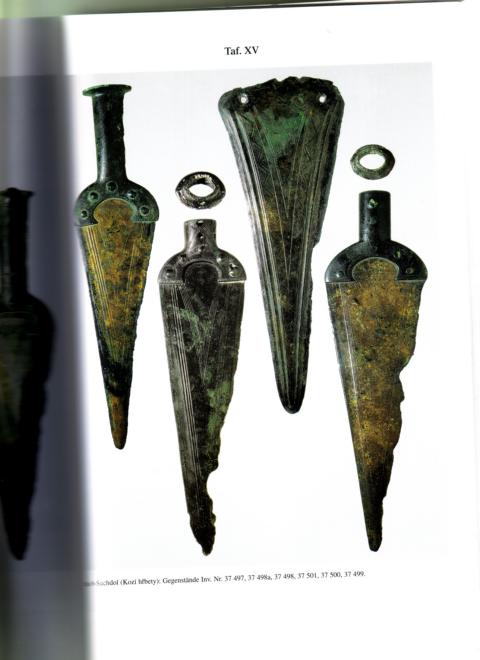
 Attachment: 22.94 KB Attachment: 22.94 KB

 Attachment: 32.37 KB Attachment: 32.37 KB
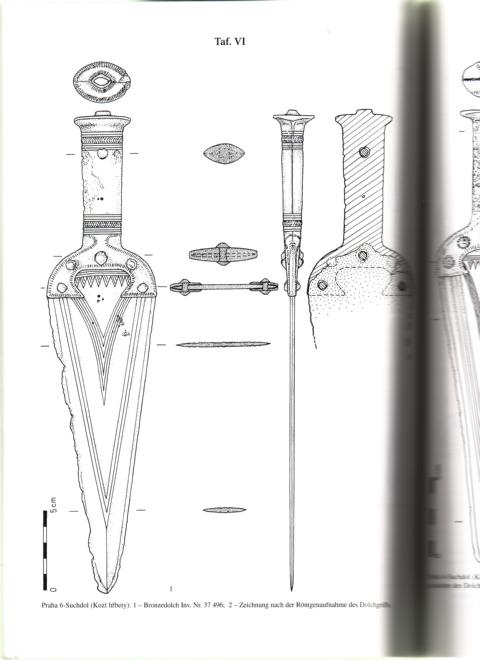
There is only one art of fence yet many ways to reach it
|
|
  |
 |
|
Vaclav Homan
Location: Hradec, Czech Joined: 22 Jan 2008
Posts: 90
|
 Posted: Wed 06 Jan, 2010 3:14 am Post subject: Posted: Wed 06 Jan, 2010 3:14 am Post subject: |
 |
|
Barrows from Unetice culture exavation near from my Haus shown that this man have object for livin. Common dagger arow and axe.
Swords from middle bronze age are from barrows.
 Attachment: 40.47 KB Attachment: 40.47 KB
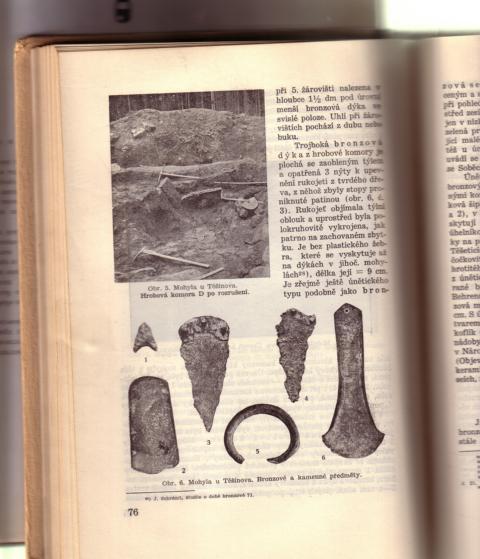
 Attachment: 65.7 KB Attachment: 65.7 KB
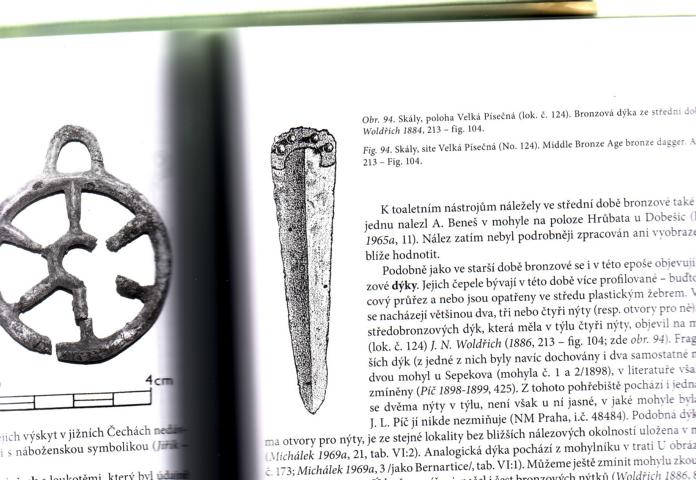
 Attachment: 31.17 KB Attachment: 31.17 KB

There is only one art of fence yet many ways to reach it
|
|
  |
 |
|
Roman Bachnak
Location: Surbiton Joined: 04 Jan 2010
Posts: 9
|
 Posted: Wed 06 Jan, 2010 3:47 am Post subject: Posted: Wed 06 Jan, 2010 3:47 am Post subject: |
 |
|
Jeroen - If weakness of the cast was not a significant problem for a bronze dagger, what could be the reason for the daggers not to be cast as one commonly in light of difficulty fitting the blade / aligning the holes? Could it be all due to the difficulty of making the mould?
Vaclav - Interesting point regarding the shortness of the hilt; on the dagger I have the hilt is indeed very short and I was wondering whether it was meant to be a dagger for a younger man. With your info about the shortness of the hilt being a general feature of these daggers, it appears that bronze age people preferred very tight grip; it is unlikely that they had smaller hands.
Roman
|
|
  |
 |
|
Jeroen Zuiderwijk
Industry Professional
|
 Posted: Wed 06 Jan, 2010 4:45 am Post subject: Posted: Wed 06 Jan, 2010 4:45 am Post subject: |
 |
|
| Roman Bachnak wrote: | | Jeroen - If weakness of the cast was not a significant problem for a bronze dagger, what could be the reason for the daggers not to be cast as one commonly in light of difficulty fitting the blade / aligning the holes? Could it be all due to the difficulty of making the mould? |
No, I think that as I mentioned they kept the same assembly as organic hilts, but replaced the organic material with bronze and kept the assembly the same as that's in their mind how the dagger should look like. You see that all the time in technology, that a change in material, technique still includes features that make no sense technologically, but are kept for aesthetic reasons. F.e. when spearheads evolve from looped (through which the spearheads were tied onto the shafts) to riveted through the socket, the loops continue to be added and eventually evolve into decorative openings in the blades of the spearheads. Socketed axes are another example, which include the wings as decoration that mimick the earlier winged axes. And in the case of Mindelheim swords, the organic scales and pommels are replaced with bronze ones on bronze hilted examples, yet they keep the complex three part hilts rather then attaching a single piece hilt.
But then again, we don't have all the information available to judge which is easier to make technologically for the casters in the bronze age. They may have known some tricks that made casting those metal hilts easy enough that it didn't matter much.
N.b. it's also possible that the metal hilts were patinated. At least on the pictures above, it seems like the hilts have a different color then the blades. So this may also have been a reason to keep the hilt seperate.
| Quote: | | Vaclav - Interesting point regarding the shortness of the hilt; on the dagger I have the hilt is indeed very short and I was wondering whether it was meant to be a dagger for a younger man. With your info about the shortness of the hilt being a general feature of these daggers, it appears that bronze age people preferred very tight grip; it is unlikely that they had smaller hands. |
They didn't have small hands, and the grips still work perfectly in modern hands. It's a common mistake that people think hilts on swords are too small to fit in modern hands, once you pick them up they fit perfectly. You have to consider that the entire hilt is the grip, including the shoulds over which the index finger and thumb are placed. In a lot of swords, the first part of the blade includes an unsharpened part on which the index finger was placed when holding the sword in a handshake grip rather then a hammer grip.
Jeroen Zuiderwijk
- Bronze age living history in the Netherlands
- Barbarian metalworking
- Museum photos
- Zip-file with information about saxes
|
|
   |
 |
Stephane Rabier

|
 Posted: Wed 06 Jan, 2010 5:14 am Post subject: Posted: Wed 06 Jan, 2010 5:14 am Post subject: |
 |
|
Hi,
I agree with Jeroen about the mutual influences of technology and tradition.
Concerning a technical obligation to have a two part dagger, could it be due to the necessity to use two different materials for the hilt and the blade for either technical or cost reasons: use a cheaper and/or more ductile alloy for the hilt and a higher quality bronze for the blade?
The shape of those daggers implies the makers originally have been obliged to use that two part system. Original wooden or bone hilts on the oldest versions could be a good reason.
Some other cultures in Asia for instance made some solid bronze daggers that were originally designed to be built that way their shape was adapted and they were not certainly weaker than their two part cousins.
|
|
  |
 |
|
Jeroen Zuiderwijk
Industry Professional
|
 Posted: Wed 06 Jan, 2010 6:25 am Post subject: Posted: Wed 06 Jan, 2010 6:25 am Post subject: |
 |
|
| Stephane Rabier wrote: | Hi,
I agree with Jeroen about the mutual influences of technology and tradition.
Concerning a technical obligation to have a two part dagger, could it be due to the necessity to use two different materials for the hilt and the blade for either technical or cost reasons: use a cheaper and/or more ductile alloy for the hilt and a higher quality bronze for the blade? |
It doesn't look like it. Frequently both are the same color metal, so they at least have the same tin contents. It may be worthwile checking for antimony though, as that seriously embrittles bronze, making it difficult to workharden edges.
Jeroen Zuiderwijk
- Bronze age living history in the Netherlands
- Barbarian metalworking
- Museum photos
- Zip-file with information about saxes
|
|
   |
 |
|
Roman Bachnak
Location: Surbiton Joined: 04 Jan 2010
Posts: 9
|
 Posted: Wed 06 Jan, 2010 1:41 pm Post subject: Posted: Wed 06 Jan, 2010 1:41 pm Post subject: |
 |
|
Jeroen / Stephane - I can imagine that in the bronze age definition of the material was rather broad; some casts had more copper / less tin then others. Local source of copper as the primary metal determined content of alloying additives. In his regard, I can say that each bronze age item I have is different in material appearance. I have one which looks like silver. Another has a polished hard look of a stone.
I speculate that each shop used just one type of bronze for all purposes - hilt, blade, anything. Differences were from shop to shop. The question is why blade and hilt on the daggers on Vaclav's images have have different appearance. Differential patination as per Jeroen's suggestion may be the answer.
Regarding the decoration on the blade was it cast as such or cut in after casting?
Roman
|
|
  |
 |
|
|

